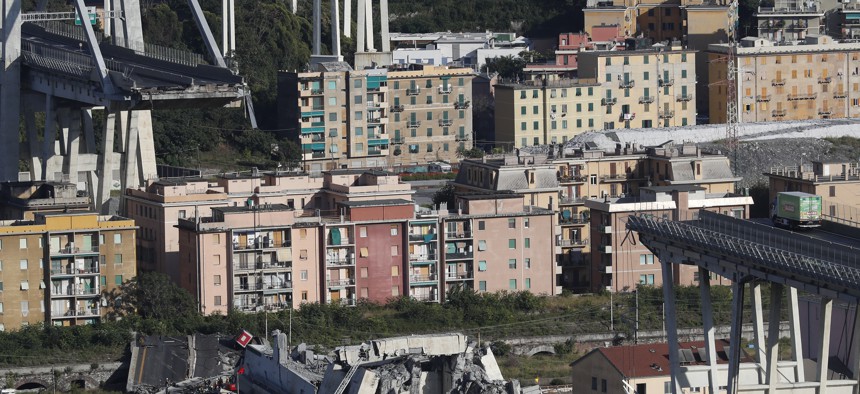More Bridges Will Collapse

A view of the Morandi highway bridge after a section of it collapsed, in Genoa, northern Italy, Tuesday, Aug. 14, 2018. AP Photo/Antonio Calanni

Connecting state and local government leaders
Two disasters in Europe are the latest examples of the decline of infrastructure—as an idea as much as a physical thing.
There’s an old chestnut about infrastructure that goes, Infrastructure is everything you don’t notice—until it fails. It’s a definition that works for any kind of infrastructure, too: big or small, visible or invisible, bridges and garage doors, electric grids and Wi-Fi routers. Infrastructure is everything you take for granted. And you only notice that you take it for granted when it breaks.
Lately, a lot of things have broken. In two incidents over the past two days, hundreds of people were injured or killed: An elevated-highway bridge collapsed in Genoa, Italy, and a pier gave out in Vigo, Spain, during a music festival. The consequences are harrowing. In Genoa, cars dropped 150 feet to the earth as a span of the bridge fell underneath them. In Vigo, concertgoers were plunged into the sea, piled atop one another, when the boardwalk gave out.
It’s too early to know for certain what the causes were of the two collapses, but “structural problems” were suspected at the Spanish boardwalk, and “signs of problems” had been observed on the Italian bridge. Those factors invoke concerns about general infrastructural decline caused by deferred maintenance (usually from lack of funding). That’s a familiar story everywhere. In the early-20th century, many structures were overengineered to hold massive loads. But as civil engineering matured, and as demand for structures increased, the profession designed structures to be safe, but also quick to erect economically. Eventually, those compromises would come home to roost. In 2007, a highway bridge in Minneapolis collapsed, killing or injuring hundreds. But even a decade later, the nation’s “aging infrastructure” remained, mostly having become a political talking point rather than a program for renewal.
But age and decay aren’t the only causes of infrastructural collapse. A portion of Interstate 85 in Atlanta collapsed in 2017 after a fire lit underneath it by a homeless man raged into an inferno. And earlier this year, a pedestrian bridge at Florida International University in Miami collapsed, killing six people. The bridge was brand new, making its collapse a failure of engineering, not of maintenance.
It’s not just bridges and roads breaking. Mark Zuckerberg has claimed that Facebook is a kind of social infrastructure, but it feels broken now, too. This week, at the Defcon computer-security conference, hackers demonstrated how to gain back-door access to voting machines used in 18 states. There’s evidencethat Russia has hacked the U.S. power grid, along with nuclear and commercial infrastructure, too. The prevalence of badly secured internet-connected data, from emails to DNA samples to credit reports, has made all information vulnerable. Last year, 143 million Americans’ personal information, including Social Security numbers, were lifted from the credit agency Equifax’s servers.
When these incidents become so frequent and so pervasive—or even just when they feel like they do—the meaning of infrastructure changes. As I wrote in the wake of the Equifax breach, “With over half of the entire U.S. adult population potentially exposed, what’s left to do but shrug and sigh?” Once they become perceived as generally untrustworthy, bridges and voting systems and utilities and the rest don’t recede into the background so easily anymore. If infrastructure always fails, you always notice it. Will this bridge I’m driving over hold? Will this vote I’m casting be counted? Will this personal data remain private?
No longer is infrastructure something invisible, something you can take for granted. Instead, it’s something that might work, or might not. Not plainly calamitous—most bridges don’t fall—but something precarious. Something that might not be trustworthy, that might wind up biting you for having put faith in it.
The same feelings of uncertainty and vulnerability that now accompany employment, education, health care, and so many other aspects of contemporary life have seeped into the foundational structures in which that life operates. That condition is not necessarily an undesirable one either, for those who might benefit from precariousness as a means of social control. It’s funny to laugh about the ongoing, unrealized promise of President Donald Trump’s “infrastructure week,” even while an estimated $123 billion backlog mounts for U.S. bridge repairs alone. But withholding solutions to infrastructural precariousness produces confusion and fear, which agitate bitterness, blame, and, sometimes, zealotry. In the case of the Miami pedestrian bridge, some focused scorn on an all-woman engineering team employed by the Cuban-American–owned contractor responsible for construction. In Flint, Michigan, a public official blamed black people who “don’t pay their bills” for the city’s ongoing water crisis.
The irony of infrastructural precariousness is that it takes big, complex, and physically imposing things in the material world and transforms them into mental phenomena. A bridge is a bridge, and its soundness can be evaluated and engineered. But the idea of a bridge, that’s just a ghost. It can fill any container in the mind, fueling whatever theory someone might make for it. That might represent the ultimate infrastructural failure: not the collapse of an individual bridge or utility or service, but the breakdown of the very idea of common foundations for social operation.
Ian Bogost is a contributing editor at The Atlantic, where this article was originally published.

NEXT STORY: In search of solid metrics for cloud SLAs




